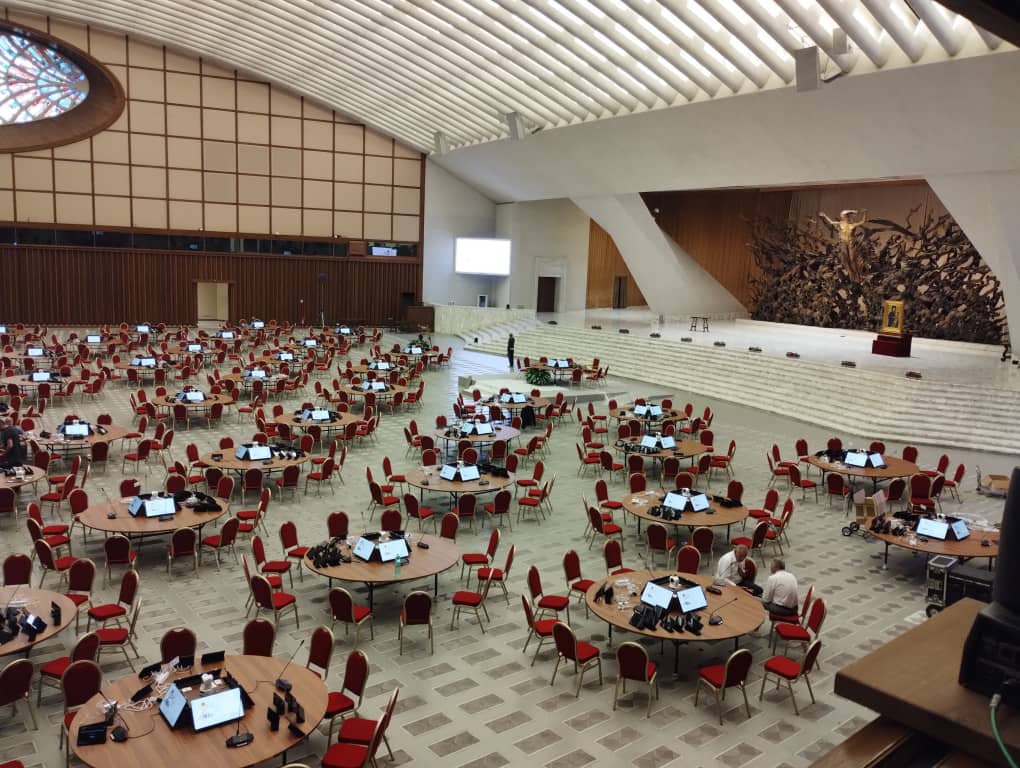VATICAN SYNOD: What is Unique to The Lay Out of Synod Hall?

Fr. Andrew Kaufa smm
This is a question that came into my mind after I read Jonathan Liedl’s article New Grammar of Synodality on Display At Start of Synod Gathering which was published by Catholic News Agency on October 4, 2023: what exactly is new about the layout in the synodal hall for the Synod on Synodality at Aura Paul II?
For those who are not aware, the setup in the Aura Paul VI where the XVI General Assembly of the Synod is taking place differs from the setting during the previous synods. Instead of using the hall where participants sit in a hierarchical arrangement of an amphitheater where the Pope and the synod facilitators take seat at the front stage which is almost like a high table arrangement. This time around, the participants are divided into 35 tables which are called working groups, and the table of the Pope and the synod organizing team are more or less in the middle of the hall, below the stage but slightly elevated.
Liedl has noted that for the first time, among the 365 participants who are full members of the assembly with voting rights including lay men and women, religious men and women as well as deacons and priests are giving interventions from their round table, seated. This working group set up a round table, according to the Relator of the Synod Card. Jean Claude Hollerich, a new grammar of synodality that the Church of our times must discover.
The New from the Old
Speaking as an African from Eastern Africa, I can agree that this is a new grammar in so far as the synod is concerned. However, it is not a new grammar when it comes to being a church in the Eastern Africa (AMECEA) and Southern Africa (IMBISA) regions of the Church in Africa. where the ecclesiology of the Small Christian Communities (SCCs) has become the way of being a church. Coincidentally, the AMECEA region is also celebrating 50 years of the SCCs. The image of a Small Christian Community is that of a community of baptized men and women, youth including the Religious men and women as the priests together sharing in a set of a circle, with the Bible as the center of their spiritual conversation about their life experiences and their mission to the world around them.
According to Bishop Patrick Kalilombe who was a leading advocate for this ecclesiology, the SCCs, or rather Basic Ecclesiological Communities can be referred to as the Second Vatican Council’s rediscovery of the theology of the faithful, an inculturation of parish ministry where the incarnation of the Gospel in the traditional set up eliminates clericalism (refer to Dictionary of African Christian Biography). Furthermore, the importance of the round table set up during SCC meetings is also underscored by the two key activities that take place during the SCC gatherings, i.e., Bible sharing and mission or charity outreach activity planning.
Of course, I am tempted we may use the round table image for lack of a proper word but the best image used on most SCCs meeting booklets has been very African: a community gathered under a tree, sharing the word of God. As a matter of fact, even the local terms used in Malawi for SCCs have reflected this concept of a small community gathered together for a purpose. Consider mphakati among the Chewa, limana among the Ngoni, mtheko among the Lomwe, or Namuri among the Mang’anja – all these terms etymologically reflect the circle set up of African meetings somewhere under the shade of a big tree where all sit down either on a mat or on stones.
Synod on Synodality: An opportunity to promote SCC Ecclesiology
This article is not to oppose Liedl and those who do not come from the same background as I. In fact, it is thanks to the Synod on Synodality, that journeying together in the Second Vatican II ecclesiology has once again come to light as a unique experience of the universal Church during diocesan, national, and continental phases of the Synod on Synodality. It is also understandable that from this experience, the people of God from around the world have appreciated this way of journeying together because it reflects in a concrete sense the equal dignity of all the baptized. In other words, since the SCC setup is a way of journeying together, a fruit of the Second Vatican Council in Africa for the past 50 years, it can be argued that the synodal experience is a call by the people of God for the Church to go back to the Second Vatican II model and implement it.
As far as I am concerned, there has never been a description of this new grammar better than Fr. Claude Boucher’s art painting which the Episcopal Conference of Malawi gave as a gift to Pope John Paul II when he visited Malawi – Pope, bishops, conference bishops, priests, Religious men and women, the laity including the youth together on a journey. Apparently, the appreciation of the round table set up by the organizers of the assembly for the 16th Ordinary General Synod of Bishops is a pointer that there is more ecclesiological grammar for AMECEA and IMBISA regions to share with the universal Church other than the sitting plan.


